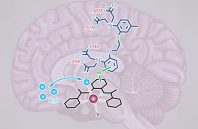Calcium is a critical signaling molecule for most cells, and it is especially important in neurons. Imaging calcium in brain cells can reveal how neurons communicate with each other; however, current imaging techniques can only penetrate a few millimeters into the brain.
MIT researchers have now devised a new way to image calcium activity that is based on magnetic resonance imaging (MRI) and allows them to peer much deeper into the brain. Using this technique, they can track signaling processes inside the neurons of living animals, enabling them to link neural activity with specific behaviors.
“This paper describes the first MRI-based detection of intracellular calcium signaling, which is directly analogous to powerful optical approaches used widely in neuroscience but now enables such measurements to be performed in vivo in deep tissue,” says Alan Jasanoff, an MIT professor of biological engineering, brain and cognitive sciences, and nuclear science and engineering, and an associate member of MIT’s McGovern Institute for Brain Research.

 (585) 768-2513
(585) 768-2513

